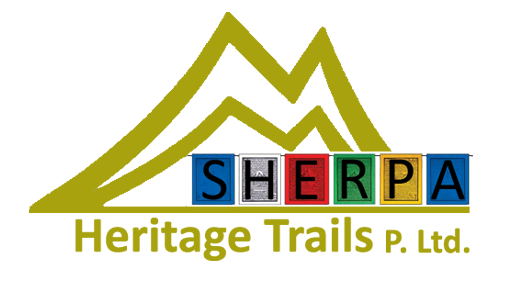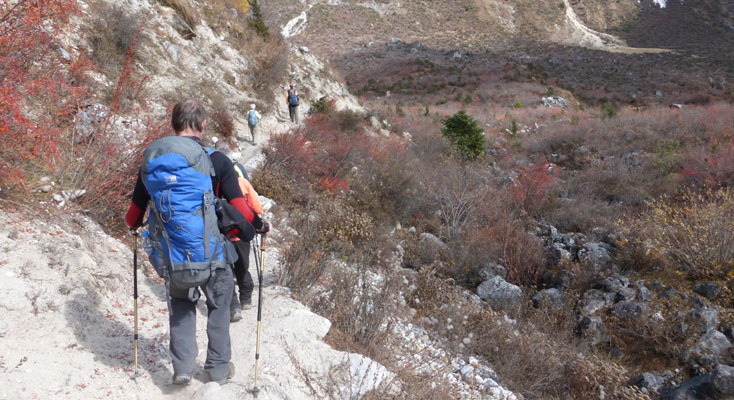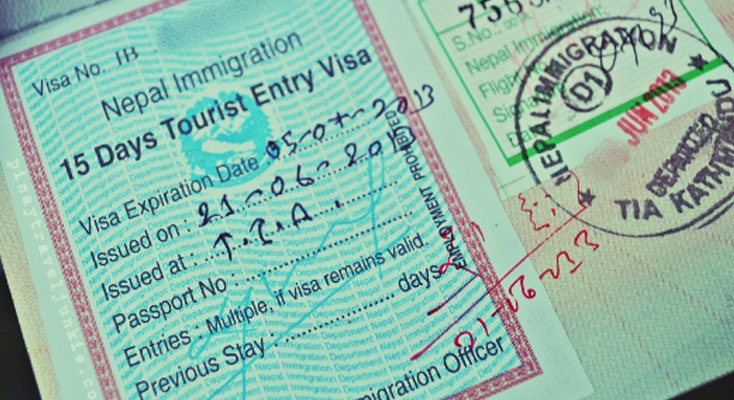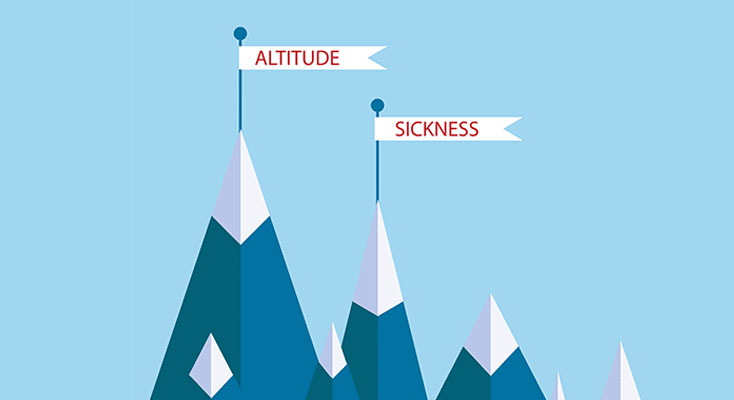Nepal Travel Guide and FAQ's

How will I know Sherpa Heritage Trails is a legal trekking agency?
All legal and certified trekking agencies of Nepal must be registered at the Nepal Department of Culture, Tourism and Civil Aviation. So we pay taxes.
Also, a registry at TAAN is compulsory. TAAN means Trekking Agencies Association of Nepal. You can find our registry here.
We are also a member of the NMA, Nepal Mountaineering Association. You can find our registry at the NMA here.
On top all our guides have successfully completed training at KEEP, Kathmandu Environmental Education Project.
Managing director Gomba Sherpa is a personal member of TAAN and the NMA for over 25 years.
What is the difference between a teahouse trek and a camping trek?
During a teahouse trek, you hike daily from teahouse to teahouse. At the teahouse, you will have your food and drinks, and you spend the night in a basic room. In teahouses, you have western toilets and sometimes only squad toilets. Teahouse treks usually are more visited by tourists than camping treks.
During a camping trek, you hike daily from one campsite to another. You will receive 3 meals every day, tea& coffee with cookies and, if possible, fresh fruit. A toilet tent will be set up each day at the campsite, and sometimes it is possible to use a basic toilet at a local teahouse. Camping treks are in remote areas where you will hardly meet any other tourists.
How long do I hike per day?
On average you will hike 4 to 7 hours per day. This is including lunch stops and short rest breaks. Sometimes a trekking day will be longer, depending on the distance between teahouses or campsites. Please check our web page about Trek Grading for more information.
How fit do I have to be to do a trek?
If you are physically and mentally fit to walk for 5 to 6 hours on moderate trails, you are qualified for trekking in Nepal. To gain fitness level we do suggest you have some physical fitness such as running, jogging, hiking, etc a few months before your trek. For a general impression of trekking grade, you can also visit our webpage about Trek Grading.
What are the basic requirements for peak climbing or expedition?
You will need an excellent level of fitness to participate fully in these high mountain adventures. Good cardio fitness which for most people requires some training, running, hiking and perhaps some gym work. Preferably this level of adventure has been a long-term interest but if not, you have set a program of fitness preparation with at least three months lead-in time to your trip.
Also, you need previous experience in mountain climbing using ropes, crampons and ice axe. The only peak you do not need previous mountaineering experience is Mera peak because there are no technical difficulties during the climb.
How about altitude sickness during trek?
On treks, higher than 3000m there is always the risk of altitude sickness or acute mountain sickness. It is important to acclimatize during the trek and drink plenty of water. If you suffer headache, dizziness, nausea or any other health complaint, you must tell your guide. All our guides are trained and qualified in first aid and know very well what to do if you are suffering from altitude sickness. For more information about altitude sickness visit our webpage about Health and Acute Mountain Sickness.
What if I do get sick during trek and/or have to go to a doctor or hospital?
All our guides are trained and qualified in first aid. Sometimes trekkers may get diarrhoea as well as sprains and muscle aches. In such case, our guide will advise you about any health requirements and also will help you treat your illness. If necessary they will help you to the most nearby health post.
If you need a helicopter or jeep rescue, they will contact the head office of Sherpa Heritage Trails. We can arrange a rescue for you. The cost of the rescue is for the travel insurance or the client. It is compulsory for all clients to have travel insurance which covers helicopter rescue and evacuation. Also, it is very important you check with your travel insurance to which altitude they will allow a rescue.
Do I have to bring my own First Aid kit?
Sherpa Heritage Trails has a basic First Aid kit available. But we do recommend bringing your own. Suggestions for your First Aid kit you can find on the download Checklist Trekking.
Do I need a travel insurance?
Yes, for all our tours, treks and climbing adventures travel insurance is mandatory. Most regular travel insurances will cover up to an altitude of 4000 m/ 13124 ft. For trekking and climbing higher than 4000 m, you will need additional insurance. Also for rafting and paragliding, you will need extra outdoor activity insurance.
Is there an age limit for joining your treks?
No, there is no age limit. If you are fit, you are able to enjoy the trails in Nepal. At a certain age, we do suggest some milder altitudes.
How about kids on trek?
If you book a trek with your kids, we strongly suggest hiring an extra porter for your children. This porter will stay with your children during each trekking day, and carry your child if it gets tired. Sherpa Heritage Trails has a high-level experience with young children, and our porters are very soft and kind to children. At the end of the trek, your child does not want to say goodbye!
What is the best season for a trek?
In general, the best season is right after the monsoon. From October until December the skies are clear because all the dust has washed away during the monsoon. The temperatures are mild and perfect for trekking. From December until January, the skies are still clear but at higher altitudes, it can be quite cold. From February until May is the spring season. Particularly beautiful because of the flowering rhododendrons.
Is it possible to trek during monsoon?
Yes, it is possible to trek during the monsoon ( July/August/mid-September). Dolpo and Upper Mustang are even better in monsoon because they are on the shadow side of the Himalayas. But Everest Base Camp, Everest region, and Langtang for instance are good options for trekking during monsoon. Usually, in the morning the skies are clear, and during the day the clouds are building up to rainfall in the afternoon or evening.
What kind of food will be served during trek?
In teahouses, you can get both local and limited western food like pasta and pizza. There are always vegetarian options available. In more remote areas you will eat local food like dhal baht (rice and lentils), curries, chapattis and noodles.
If you are doing a camping trek we offer standard meals, often vegetarian meals.
If you have any dietary requirements please let us know in advance to make the necessary arrangements.
Do I need to bring a water filter?
If you have one, great, take it with you. During the teahouse trek, you can buy safe drinking water in bottles or filtered drinking water. During the camping trek, we will boil water for you.
At the moment we are testing several water filters to find out which are easiest to use on the trek. In future we want all trekkers to use filtered drinking water to reduce the use of plastic bottles. This is part of our responsible tourism policy. For more info about responsible tourism check out our web page.
What kind of equipment should I bring for a trek?
We have a checklist available for you. You can download it here.
How many extra days should I allow in case of flight cancellation?
If you are flying from a remote mountain strip like Lukla, Paphlu, Jomsom, Simikot, Taplejung and Dolpo, you should keep at least 2 spare days before your international departure home.
What kind of hiking shoes do I need for trek?
We recommend hiking shoes boots with ankle support which reduces the risk of injury, especially at higher altitudes. It is important that your boots are comfortable, well worn-in and not brand new. We do not recommend trekking in sandals, tennis shoes or using new boots prior to the trek.
Do I have to bring my own sleeping bag during trek?
Yes, we strongly recommend bringing your own sleeping bag. Most teahouses have 1 or 2 blankets in the rooms, but in tourist season there are no extra blankets available. Bring a sleeping bag with a comfort temperature up to -10/15 C. It is possible to hire sleeping bags in Kathmandu or Pokhara.
Can I hire equipment in Nepal?
Yes, you can hire equipment in Kathmandu and Pokhara, and limited hire is available in Lukla. You can hire down sleeping bags and down jackets. We do recommend bringing the basic equipment from your home country because the quality of equipment is far less reliable in Nepal.
For peak climbing and expedition it is possible to hire climbing gear and equipment in Kathmandu.
Do I have to carry my own bag during trek?
During the teahouse trek, you will carry your own bag. It is possible to hire a porter to carry your luggage. In this case, you only have to carry a day pack. A porter can carry luggage for 2 trekkers. So 1 porter for 2 trekkers, with a maximum load of 25 kg.
During the camping trek you will carry your day pack and porters will carry the rest of your luggage and camping equipment.
Can I store my luggage when I am on trek?
Nearly all hotels have a luggage deposit. It is also possible to store your luggage at the office of Sherpa Heritage Trails. After you come back from the trek, we will hand over your luggage to you. It is also possible to store your luggage at the Guesthouse in Pokhara.
Can I send a message to home during trek?
The reach of the mobile network signal in Nepal is getting quite big. At the famous trails and treks, you are able to use your mobile phone. During these treks, there will only be a few days when you are unable to connect to the network. Often in teahouses Wi-Fi is available, but this is depending on electricity and the quality of the Wi-Fi connection. During treks in remote areas like Dolpo and Kanchenjunga, the facilities are far less, and it sometimes will take a week or more before you are able to contact home.
Your guide will regularly contact head office in Kathmandu during the trek to check for any messages.
Is it possible to take a hot shower during trek?
Yes, during the teahouse trek you can take a hot shower. However, the hot water comes from sun boilers, if the boiler is empty a hot shower turns into a cold shower. Often a warm bucket shower is possible as well.
Is it possible to charge my phone, camera of powerbank during trek?
Yes, in teahouses electricity is available. Often teahouses charge a charging fee, the fee varies from 100 rupees up to 500 rupees. If you own a solar charger, we recommend bringing your solar charger.
How about trekking staff welfare?
On each trek, our company has proper medical & emergency rescue insurance for all our staff. We make sure they have proper clothing and shoes and provide them with proper clothing and shoes if needed. This is part of our Responsible Tourism policy, for more details about our policy please check our web page.
Are there any ATM’s in Nepal?
Yes, in Kathmandu, Pokhara and Lukla you can find ATMs. Sometimes they are out of order, but generally, you can get cash money. We do recommend not to cash big amounts at one time. You can also exchange foreign currency at local money exchangers. They often use an exchange commission which is cheaper than the bank. During the trek, it is not possible to go to an ATM or money exchanger.
How much money do I have to take with me on trek?
It depends on your package deal. If you have agreed on a full package deal; accommodation, food & drinks and fresh fruit are included. You only have to pay for alcoholic beverages, soft drinks and snacks. We recommend €20,00 ( in Nepali Rupee currency) per person per day. The same amount applies to camping treks.
If you pay teahouse and food& drinks yourself, we recommend at least €30,00 ( in Nepali Rupee currency) per person per day. Everest region and along the Annapurna Base Camp trail the prices are higher. If you want to drink alcoholic beverages, soft drinks or buy snacks you should bring extra money. In this case, we recommend €40,00 per person per day.
Do I need a visa to visit Nepal?
Yes, all foreign nationals, except Indian citizens, need a visa to enter Nepal. You can get your visa at the Nepalese Embassy or Consulate in your home country. For more detailed information please check our webpage about visa for Nepal.
Who will pay for the extra days if we get stuck due to flight cancellations?
Clients have to pay themselves for the extra costs. Please check our Booking Terms & Conditions for more information.
What is your payment policy?
You can check out all details about deposits and payments on our Booking Terms & Conditions and Payment Modes.



